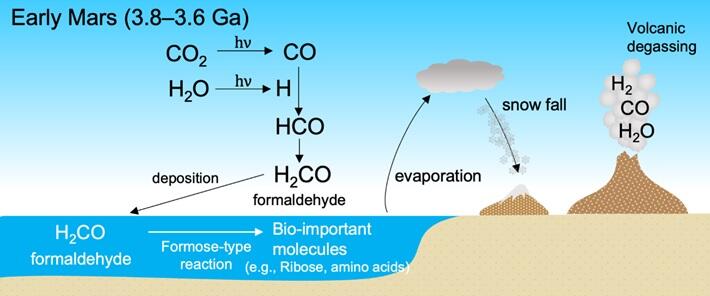It is believed that approximately 3.8-3.6 billion years ago, Mars possessed a climate similar to present-day Earth, featuring oceans and warmer temperatures. However, the extent to which formaldehyde, a raw material for bio-important molecules such as amino acids and sugars, was formed in such an environment remained unknown. A research group led by Graduate Student Shungo Koyama, Professor Naoki Terada, and Associate Professor Yoshihiro Furukawa of the Department of Geophysics at the Graduate School of Science, at Tohoku University, has estimated the amount of formaldehyde production in the ancient Martian atmosphere utilizing a photochemical model of the atmosphere. This study revealed that formaldehyde was continuously generated during the warm period on Mars in ancient times. The findings were published in Scientific Reports.

Provided by Shungo Koyama
Using the same model, the research group calculated the quantity of formaldehyde generated under conditions simulating the ancient Martian atmosphere. As a result, it was discovered that during a broad period spanning approximately 4-3 billion years ago, a substantial quantity of formaldehyde was generated in the atmosphere through chemical reactions, provided that hydrogen expelled from volcanoes was present at a certain level. In particular, it has been demonstrated that formaldehyde was most efficiently produced during the warm period approximately 3.8-3.6 billion years ago.
Ribose (sugar), a component of ribonucleic acid (RNA), is believed to have played a crucial role in the origin of life. Based on the calculated amount of formaldehyde in this study, the research group combined it with experimental data from previous Formose reactions. Through this approach, they estimated the quantity of ribose produced in the ancient oceans of Mars. As a result, it was suggested that only during the warm period of ancient Mars, bio-important sugars such as ribose were continuously produced.
NASA rovers are presently conducting geological surveys on Mars. From the data obtained, the research group is also gaining insights into the characteristics of organic compounds of the age estimated in this study. They aim to estimate the characteristics of organic compounds that accumulated in the geological strata of that time, based on features such as isotopes of formaldehyde that could be inferred from the generated data in this study. They intend to compare this information with the obtained data to gain a more detailed understanding of how organic compound formation progressed on Mars during that period. As part of this effort, they aim to shed light on where on Mars bio-important molecules were more likely to form based on the combination of surface topography and estimated climatic information from that period.
Journal Information
Publication: Scientific Reports
Title: Atmospheric formaldehyde production on early Mars leading to a potential formation of bio-important molecules
DOI: 10.1038/s41598-024-52718-9
This article has been translated by JST with permission from The Science News Ltd. (https://sci-news.co.jp/). Unauthorized reproduction of the article and photographs is prohibited.




